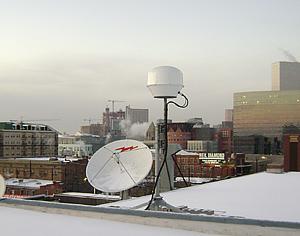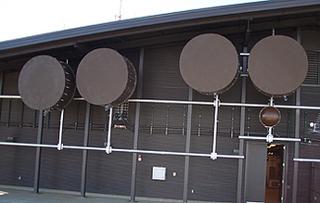Ahead of the Relocation Curve

Eric Buckland, KCNC engineering manager and Chris Jones, KCNC engineer.
DENVER -- The BAS transition has prompted Denver CBS O&O KCNC-TV to redesign its microwave systems from the ground up and implement the advantages inherent in digital microwave technology. The new design took place in coordination with the construction of a new multistation facility on Lookout Mountain for transmission of DTV in the Denver area.
The BAS relocation project was "fairly timely for us to fit in a road we were already heading down," said Eric Buckland, KCNC engineering manager. "In 2003, we had just replaced most of our backhaul microwave with digital ready radios."
With the new digital gear, KCNC outfitted receive sites and ENG trucks with dual band (2/6.5 GHz) digital microwave gear. The changeover also allowed KCNC to implement camera back digital microwave systems and a diversity receiver system located at the Lookout Mountain transmitter site.

NSI Silhouette and Andrew antennas atop KCNC studio building in downtown Denver.
COFDM EXPERIENCE
KCNC had gained some experience with digital microwave when in 1999 they outfitted their helicopter with a proprietary COFDM microwave transmitter.
"We got our feet wet with the helicopter and in 2003 we outfitted one of our ENG trucks with a digital ready transmitter," KCNC Engineer Chris Jones said. "The whole Nextel project was serendipitous in the sense that we had committed to go digital on our own because of all the things it is: bandwidth efficient, video is better, the signal is remarkably robust. We had luckily gone the way of first upgrading the backhaul infrastructure and about the time we considered doing the trucks, the Nextel project showed up. We definitely didn't need any selling on going to digital. When we first got wind of this project we knew that if this happened it was going to be awesome."
KCNC Uses MER to Judge Signal Quality Throughout their early use of digital microwave, KCNC discovered that measuring Modulation Error Ratio (MER) was the preferred method for judging the quality of a digital microwave signal. "Initially we would punch up the MastCam on a truck, point it at traffic and look for macro blocking," said KCNC Engineer Chris Jones. "We were trying to figure out what sort of metric to use to gauge the quality of a live shot. Bit Error Rate is one of those things that sort of tells you what you already know. Your pictures are frozen by the time you see that your BER is shot. We were trying to find a way to see that coming on, and through trial and error and research we came across MER as the best way to tune in a live shot."
Jones compared the process to FM in which the engineer in the truck observes the waveform monitor and listens to the audio until the chroma stops fluttering in order to achieve a good shot.
KCNC installed these microwave antennas atop Lookout Mountain, site of the station's transmission facilities. "It's pretty intuitive to tune in an FM live shot but that's not so for digital live shots," he said. "We had to come up with methods as we went along and I think that's why Nextel as an organization came and visited us early on because they knew we had fumbled our way through a lot of the early stuff and had come up with a reasonable system for tuning in live shots digitally. Ideally it's nice to have a spectrum viewer and then also to have some quality metrics that let you know you're approaching the cliff. BER lets you know you've fallen off the cliff but MER lets you know you're approaching it."
Initially KCNC used Tandberg IRDs for monitoring. These IRDs have a Web interface that provides an MER value.
"The MER in the Web interface required refreshing; it wasn't a dynamic meter," Jones said. "We've been using that up until now when we got our new NSI gear which has constantly refreshing meters that indicate both MER and Receive Signal Level [RSL]."
The NSI MC5 controller offers a GUI which displays a bar graph of MER and RSL as derived from the digital microwave receivers.
—Andy Morris

Buckland explained how KCNC took the opportunity of the BAS relocation project to greatly enhance their microwave system. "We were able to design an enhanced system with the Sprint Nextel Dock Swap program. In this Dock Swap program, Nextel totaled up the value of equipment they had agreed to replace. Approximately 60 percent of it made sense in our new plan but we weren't constrained in building a digital network exactly like our old analog network. We were able to accent that and do our own touch on a system of the future.
"At a certain number of receive sites we were able to put a little additional money into it and we upgraded all of our trucks and a majority of our receive sites to operate not only in the 2 GHz band but in the 6.5 GHz band," Buckland continued. "This was good timing since in our market the 2 GHz band is overly congested. We had more receive antenna systems than we needed in our future sites so instead of buying one for one for everything we had authorized under the Dock Swap program, we turned some of those dollars into 6.5 GHz operation at the sites we were working on."
Buckland said that because KCNC had a whole year's prior experience with digital backhauls, the station "now has the best backhaul network in market."
"Through our early experience," he said, "we recognized some of the issues and were able, to a degree, to tailor the Nextel project to design and build that network."
EASE OF OPERATION
KCNC chose NuComm Newscaster VT2 transmitters and CR6D receivers for much of their new digital microwave system.
"The main selling point of the NuComm gear was its ease of operation," Jones said. "There were a number of preset buttons on the front panel of the transmitter. An engineer can set up these presets and just tell an operator to press the appropriate preset button."
Buckland added that NuComm offered KCNC a free VSB option on all their gear if purchased exclusively from the company. "VSB is more bandwidth efficient, if less robust than COFDM and we plan to experiment with using VSB transmission for certain fixed link applications," he said.
At presstime, Sprint Nextel planned to convert the Denver market in January.
Get the TV Tech Newsletter
The professional video industry's #1 source for news, trends and product and tech information. Sign up below.
